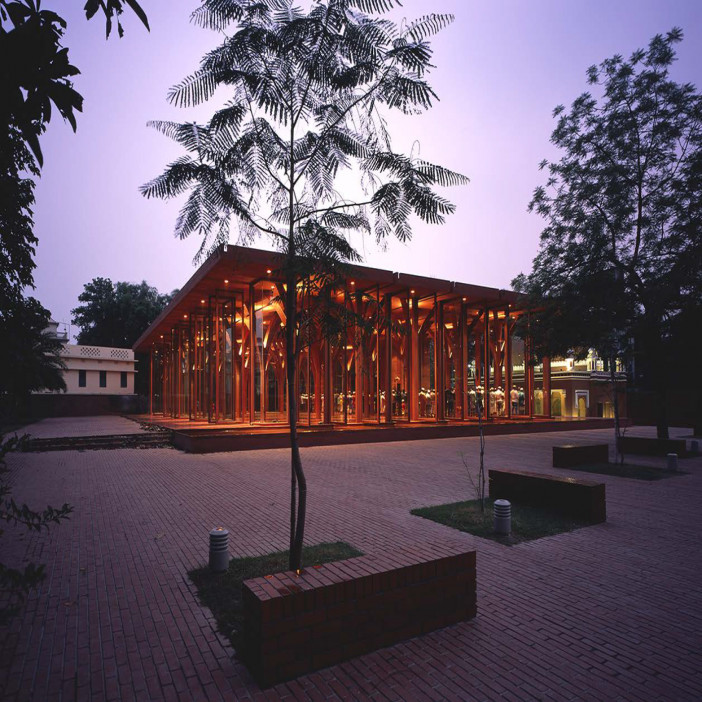The Red Mosque
History
Dhaka, which is now four hundred years old, grew from the banks of the river Buriganga but perhaps inexplicably, grew only northwards and not substantially on its other bank to the south. It was much later that the area south of the river grew to be what is now part of Keraniganj, of very high densities and irregular unplanned growth. The Red Mosque is located in such a dense residential area serviced by narrow roads, with hardly any parks, playgrounds or opens spaces. The existence of a two-hundred year old mosque and the clients intention to preserve it, was the generator of the design. However, from the first instance, the architect felt this should be more than a place of worship for a people for whom religion is already central to their daily lives. Here was an opportunity to open up hitherto blocked or unused spaces and make it accessible to the community.
Urban and Architectural
The Mosque Inspired by the simplicity of the first mosque in Islam, the prophet’s mosque, the Red Mosque takes on a true pavilion form, open visually on all sides and to the elements on three. Large eighteen-foot tall apertures let in welcome breeze, obviating the need for air-conditioning in a climate where summers can get very hot. A shallow body of water encircles the main prayer space, separating it from the adjacent garden and plaza and offering micro-climatic cooling. This concept of freeness continues in the structure itself: The roof is a series of slabs separated by a light gap and held in place by columns branching out like trees to hold adjacent sections. In straight perspective, these appear to form arches, a subtle reference to traditional examples, not unlike the old mosque which it faces to its west. The slabs rise and bulge at the centre to form an ovoid form, giving a larger central space. Underneath the mihrab and mimbar are simply delineated, visible from long distances because of the wall-free design. Bathed in light, the tall scale of the interior do not overwhelm yet brings in the colors of adjacent greens as well the reddish brown of the older structure. In an area where there is so much pollution, noise and visual chaos, the mosque and its environs are conceived as a sanctuary of peace and simplicity. Palette of materials is limited: Exposed red concrete for structure and local red terrazzo for floors. So are architectural elements: columns, slabs and a tall glazing to protect from cold winters or dust when not in use. The open spaces are articulated unambiguously, leaving generous spaces for the gathering of friends or simply for the eye to travel or the mind to rest.
Description
Details
Location
Kodomtoli Bus Stand, Keraniganj, Bangladesh
Worshippers
1000
Architect Name
Kashef Chowdhury/ URBANA
Year of Build
2017
Area
3218 SQM
Drawings
Map
History
Dhaka, which is now four hundred years old, grew from the banks of the river Buriganga but perhaps inexplicably, grew only northwards and not substantially on its other bank to the south. It was much later that the area south of the river grew to be what is now part of Keraniganj, of very high densities and irregular unplanned growth. The Red Mosque is located in such a dense residential area serviced by narrow roads, with hardly any parks, playgrounds or opens spaces. The existence of a two-hundred year old mosque and the clients intention to preserve it, was the generator of the design. However, from the first instance, the architect felt this should be more than a place of worship for a people for whom religion is already central to their daily lives. Here was an opportunity to open up hitherto blocked or unused spaces and make it accessible to the community.
Urban and Architectural
The Mosque Inspired by the simplicity of the first mosque in Islam, the prophet’s mosque, the Red Mosque takes on a true pavilion form, open visually on all sides and to the elements on three. Large eighteen-foot tall apertures let in welcome breeze, obviating the need for air-conditioning in a climate where summers can get very hot. A shallow body of water encircles the main prayer space, separating it from the adjacent garden and plaza and offering micro-climatic cooling. This concept of freeness continues in the structure itself: The roof is a series of slabs separated by a light gap and held in place by columns branching out like trees to hold adjacent sections. In straight perspective, these appear to form arches, a subtle reference to traditional examples, not unlike the old mosque which it faces to its west. The slabs rise and bulge at the centre to form an ovoid form, giving a larger central space. Underneath the mihrab and mimbar are simply delineated, visible from long distances because of the wall-free design. Bathed in light, the tall scale of the interior do not overwhelm yet brings in the colors of adjacent greens as well the reddish brown of the older structure. In an area where there is so much pollution, noise and visual chaos, the mosque and its environs are conceived as a sanctuary of peace and simplicity. Palette of materials is limited: Exposed red concrete for structure and local red terrazzo for floors. So are architectural elements: columns, slabs and a tall glazing to protect from cold winters or dust when not in use. The open spaces are articulated unambiguously, leaving generous spaces for the gathering of friends or simply for the eye to travel or the mind to rest.
Description



